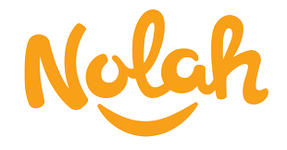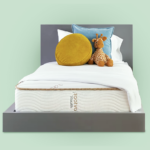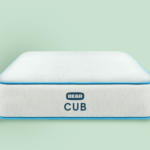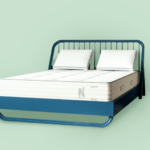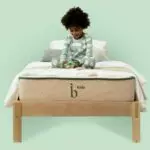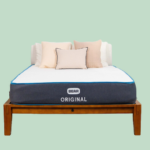Table of Contents
When you tuck your child into bed for the night, you may have to pull out all the stops to help them fall asleep, from white noise machines to stacks of bedtime stories. While sleep routines and relaxing environments are important, you may be overlooking one critical factor to quality sleep—your child’s mattress.
The right mattress can promote good quality sleep which plays a big role in a child’s learning, memory formation, emotional regulation, and physical and mental health . Poor or lack of sleep can lead to mental health and behavioral challenges , including stress, depression, anxiety, and aggressive behaviors.
Mattresses designed specifically for kids are ideal for a comfortable sleep environment and to support a child’s physical growth. “Since children’s bodies are growing and developing, it is important to make sure that the mattress has a firm surface that provides the support needed for healthy spinal alignment,” says Debbie Gerken , a registered Neonatal Intensive Care Unit (NICU) nurse and certified pediatric sleep coach.
We selected mattresses that are both comfortable and supportive enough for a child. As part of our selection process, we interviewed pediatric sleep experts and consulted with parents about the important qualities to look for in a mattress for children. Our top mattress picks are safe, made from non-toxic materials, supportive, and durable enough to last throughout childhood. Find out which mattress can help your little one have their best night’s sleep.
Best mattress for kids overall
The Saatva Youth embodies the three most important qualities of a mattress for kids—safety, durability, and support. Its convenient set-up is ideal for busy parents, which is one of the reasons this mattress stands out above the rest.
Our pick for the best mattresses for kids
- Best mattress for kids overall: Saatva Youth
- Best twin mattress for kids: Bear Cub
- Best full-size mattress for kids: Nolah Nurture Kids
- Best organic mattress for kids: Birch Kids Natural
- Best memory foam mattress for kids: Bear Original
- Best hybrid mattress for kids: Helix Kids
HelpGuide Handbook’s mattress testing methodology
The Handbook Team hand-tests every mattress we review. We evaluate brands and models by recording our findings on a 42-question standardized testing form to identify standout features and services, document issues with each product, and describe our personal experience lying on each mattress. For example, we record:
- Firmness score and whether the mattress is best for back, side, or stomach sleepers.
- Starting temperature of the mattress and how much it heats up after two testers lie on the mattress for five minutes.
- How many times a 10-pound ball bounces on the mattress after dropping from a height of two feet in order to arrive at a mattress bounce score.
We paid close attention to specific considerations that sleepers of all ages seek, as identified by respondents in our survey of 600 mattress owners. This included price, features, and the set-up process. We also interviewed real people to better understand the motivations behind shopping for a new mattress, as well as the benefits of purchasing one.
According to our survey
According to our survey, about 80 percent of all respondents said their new mattress helps them sleep better, and 65 percent reported improved mental health.
As our testers evaluated each brand and its features, we considered why many people choose a new mattress in the first place. Of our respondents, 42 percent decided to purchase a new mattress for “improved comfort and support for better sleep,” while only seven percent did so for “pain relief and targeted support.” The most common pain respondents wanted relieved was lower back pain.
Despite only 42 percent of respondents prioritizing comfort and support for better sleep when shopping for a new mattress, 68 percent reported they sleep longer on their new mattress and 49 percent and 45 percent, respectively, said their stress and anxiety had improved after switching to their new mattress. Almost all mattress owners we surveyed (95 percent) were at least somewhat satisfied with their new mattress. We consulted sleep experts, physical therapists, occupational therapists, and pain specialists to understand what mattresses offer that make an overwhelmingly positive impact.
In order to focus on the mattresses themselves, we structured our test designs to objectively rank each one based on a range of criteria. For example, we tested things like bounce, edge support (the sturdiness of your mattress edge), and cooling capabilities the same way on each mattress and compared the results. That way we can accurately compare each mattress’s score in an unbiased way while also sharing our subjective point of view as mattress testers and experts.
Lastly, we compared warranty lengths, trial periods, and white glove delivery (in-home delivery and setup) options. While most brands offer warranties, not all are comprehensive. And many brands on the market don’t have free white glove delivery. This could be a deal-breaker if you’re nervous to invest in a new mattress because you’re worried the bed won’t get set up properly or offer what you need.
From our tester
“During our research, we realized that the brand’s firmness scale and perceived firmness aren’t always the same. We decided to report how firm we thought the mattress felt so that you can gain a different perspective, but more importantly, feel confident about what you’re purchasing.”
A note on our testing
We acknowledge that every body is different, and what feels comfortable to one person may not feel comfortable to another. Throughout our reviews, we refer to weight categories as light (below 130 pounds), average (130 to 250 pounds), and higher-weight (above 250 pounds) to distinguish between body weights.
Typically, lighter sleepers perceive mattresses to feel firmer than they are, and higher-weight sleepers perceive mattresses to feel softer than they are. Keep in mind that most mattresses are designed for the average-weight person.

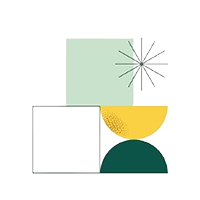


HelpGuide Handbook best mattresses for kids
These are the top five things you need to know about mattresses for kids:
Comparison of the best mattresses for kids
|
Price
|
$795–$1,055 | $695–$845 | $919–$1,224 | $1,123.80–$1,373.80 | $786–$1,690 | $748.80–$998.80 |
|
Firmness
|
6/10–7/10 (firm side); 5/10 (soft side) | 6.8/10 | 4/10–5/10 (soft side); 6/10–7/10 (firm side) | 4/10–5/10 (soft side), 6/10–7/10 (firm side) | 8/10 | 4/10–5/10 (soft side), 6/10–7/10 (firm side) |
|
Material
|
Innerspring | Hybrid | Hybrid | Hybrid | Foam | Hybrid |
|
Warranty
|
Lifetime | Lifetime | Lifetime | 25 years | Lifetime | 10 years |
|
Trial period
|
365 nights | 120 nights | 120 nights | 100 nights | 120 nights | 100 nights |
|
Best for
|
Spinal support, durability, and customer service | Edge support and stability in a twin mattress | Lasting comfort and durability as kids grow | Organic, hypoallergenic materials | Staying cool while providing comfort to back and side sleepers | Combination sleepers and potty training children |
The best mattresses for kids reviews
Best mattress for kids overall: Saatva Youth
Our final verdict on the Saatva Youth
The Saatva Youth mattress is made from natural, non-toxic materials and has a flippable design meant to provide your child the proper support and comfort as they grow. The first side is designed for kids ages three to seven. It has a support foam layer that helps maintain proper spinal alignment, which is crucial for growing kids. The dual-sided coils provide flexibility that make it easy for your child to move around on the mattress. The other side is designed for children ages eight to 12. It has high-density comfort foam, making it both softer and cooler. In addition, the softer side of the Saatva Youth mattress still maintains proper spinal alignment by enhancing support in the center third of the mattress, where an older child’s body weight is concentrated.
“When selecting a mattress for children, prioritize quality, support, comfort, and safety. Therefore, it is a worthwhile investment to purchase a good quality mattress than getting one that is old and used.”
Debbie Gerken ,a registered NICU nurse and certified pediatric sleep coach.
One of the best perks of the Saatva Youth is the convenience. Not only is this bed designed to adapt to your child’s growth, but it also comes with free white glove delivery. Saatva will personally set up your new mattress and take away your child’s old mattress (if they have one), for no additional cost. The Saatva Youth is the only mattress in this review offering this service for free.
One downside is this is the only mattress reviewed here that isn’t certified GREENGUARD Gold Certifies that a product has low chemical emissions to reduce indoor air pollution and lower the risk of chemical exposure . However, it’s still made with eco-friendly and non-toxic materials.
To learn more about Saatva, read our Saatva review .
Best twin mattress for kids: Bear Cub
Our final verdict on the Bear Cub
The Bear Cub is a hybrid mattress combining memory foam, responsive foam, and coils. We chose this mattress as the best twin mattress for kids because of the reinforced coils surrounding the edge. Since twin mattresses have the smallest surface area, you might worry more about your child rolling off a twin mattress than if you had a full or larger mattress. With the Bear Cub, the reinforced coils provide additional stability to cradle your child toward the center of the bed and reduce the chances of rolling off.
“The edge support can provide a sense of comfort for children as they can freely move about their sleep space without feeling like they will roll off the edge. In addition, edge support adds to the durability and overall longevity of the mattress as it tends to reduce sagging with heavier activity over time.”
Debbie Gerken ,a registered NICU nurse and certified pediatric sleep coach.
The Bear Cub is made of allergen-free and fiberglass-free material. The foam in this mattress, and all of the mattresses in this review, are CertiPUR-US certified CertiPUR-US is a certification that shows the foam in the mattress has been crafted with no ozone depleters. so you know you will receive a mattress with quality foam that meets certain standards for durability, emissions, and content.
The cost to have the mattress installed and an old one removed is an additional $175, while the cost for mattress removal only is $100.
Best full-size mattress for kids: Nolah Nurture
Our final verdict on the Nolah Nurture
A key feature of the Nolah Nurture mattress is that it comes with a limited lifetime warranty, and you can add a 10-year protection plan to your mattress purchase for only $0.99. The Mulberry Protection Plan covers common accidents from children or pets, including rips, burns, punctures, and more.
The Nolah Nurture is made from organic cotton, which is designed to protect against allergens and moisture. You don’t need a specific foundation for this mattress; it’s compatible with any type of bed frame, including box springs, slatted bases, and adjustable bases. Unlike Saatva, Nolah doesn’t recommend a specific age for either side of the mattress. Since every child is different, you and your child can determine when to flip the mattress.
Despite Nolah Nurture’s 120-night sleep trial, you will have to pay a return fee of $99 if you return your mattress within that time period. Although this is a significant downside, we feel the affordable accident protection plan makes up for this fee.
Best organic mattress for kids: Birch Kids Natural
Our final verdict on the Birch Kids Natural
The Birch Kids Natural mattress is one of our top picks because it provides the safety of natural and organic materials and the longevity of a dual-sided mattress. Like many mattresses here, this one is designed to last your child into their pre-teen years since you can flip it when they are ready for something softer. The mattress cover is made from soft organic cotton. Inside, the plush wool is fire retardant and designed to prevent allergens from building up. Additionally, the natural latex material is designed to make the mattress supportive, comfortable, and breathable. However, if your child is allergic to wool, you should talk to their doctor before purchasing.
When testing the adult version of this mattress, it showed good responsiveness, which is ideal for kids who tend to move around during sleep more than adults do.
From our tester
“When I rolled around, the material responded well to movement. The springiness of the mattress made it easy to switch positions.”
The Birch Kids Natural mattress comes with a 25-year warranty. Although it isn’t quite as good as a lifetime warranty, it is longer than most. Birch Kids also offers white glove delivery for an additional cost. For mattress removal only, the cost is $119, while in-home setup and mattress removal costs $159. You can also pay a little more if you want them to remove or set up an adjustable base or other foundations.
The brand also offers a 10-year accident protection plan, but unlike the affordable price from Nolah, theirs costs $79 for a twin and $99 for a full. However, the trial period is less appealing than others on this list. You can test out the mattress for 100 days, and if you want to return it within that time period, you will have to pay a $99 return fee.
Best memory foam mattress for kids: Bear Original
Our final verdict on the Bear Original
The Handbook Team was most surprised by how well the Bear Original performed in responsiveness. Usually, memory foam mattresses cause the sleeper to feel more “stuck in” the mattress rather than resting on top of it. The sinking feeling can make it difficult to change sleeping positions. However, our tester didn’t feel stuck at all. In fact, it was easy for her to move around and reposition herself. As a result, your child shouldn’t have any trouble moving around and readjusting as well.
This organic mattress is made from non-toxic materials that are fiberglass-free and GREENGUARD Gold Certified.
From our tester
“I felt like the mattress was really easy to move around on. I didn’t feel like I was fighting the material to move.”
The one downside is the warmth of memory foam. To learn more, we asked NICU nurse and pediatric sleep coach Debbie Gerken about memory foam mattresses for children. “Memory foam mattresses are not as breathable as other mattresses. Therefore, they can retain more heat which can cause sleep disturbances if a child becomes too warm,” says Gerken.
While this is true, our tester found that the Bear Original actually performed well in cooling. She recorded the temperature with a thermal gun A tool that uses thermal imaging to measure how quickly the bed’s surface heats up after someone lays in it. before lying on the mattress and after lying on it for five minutes. The temperature only increased by 7.5 degrees Fahrenheit. The cooling capabilities are likely due to the Tencel A brand of sustainable cellulose fiber made from wood pulp, which is used in clothing, footwear, home linens, carpets, mattresses, and pillows because it’s highly breathable, hygienic, and comfortable. cover. Tencel is a material that is known for being breathable and moisture-resistant.
Best hybrid mattress for kids: Helix Kids
Our final verdict on the Helix Kids
The Helix Kids mattress also offers two different firmness levels, one on each side so you can flip it as your child grows and needs a softer mattress . Helix recommends the firmer side for ages three to seven and the softer side for ages eight to 12. However, since every child is different, you and your child should ultimately decide when to flip the mattress. The mattress cover is hypoallergenic and made with Tencel, a water-repellent finish, and a hygienic microbe shield that fights odors.
From our tester
“The foam is very responsive, so it was easy to move around on.”
One of the downsides of the Helix Kids mattress is that the warranty and trial period are shorter than other mattresses featured in this review. However, you do have 100 days to test out the mattress, and if you want to return it, you can do so free of charge. Some mattress companies will charge you a return fee, so it’s great to have the peace of mind that you have time to test it out and return it without any risk.
Frequently asked questions
We found the best mattress for kids is the Saatva Youth mattress. It’s made from safe, non-toxic materials and is designed specifically for growing kids to last into their pre-teen years. But each mattress has different components and features, so you should choose a mattress for your child based on their age, weight, and personal preferences.
Kids need a mattress with enough support to promote healthy spine alignment. When they’re younger and growing, a firmer mattress is necessary to provide that support, and as they get older, they can transition into something slightly softer that still offers significant support as they continue to grow.
The size of your kid’s mattress is all about preference. Some parents may want a larger mattress that can last through their child’s pre-teen years, while others may want a twin size to fit a small room or a bunk bed.
When your child is young, they may need a medium-firm mattress somewhere between six or eight out of 10 on the firmness scale. As they get older, they can transition to something softer with more give as they change sleeping positions.
When mattress shopping for kids, you should be wary of any mattress that is too soft. If your child sinks into the mattress, it likely won’t have enough support for them. Additionally, you should avoid getting a used mattress since it can sag and lose support over time.
- Gehrman, E. (2022). A Child’s Need for Sleep. Harvard Medicine. Link
- Kids’ Sleep Linked to Brain Health. News in Health. Link
- Scott, A.J., Webb, T.L., Martyn-St James, M., Rowse, G., & Weich, S. (2021). Improving sleep quality leads to better mental health: A meta-analysis of randomised controlled trials. Sleep Medicine Reviews, 60, 101556. Link
- De Koninck, J., Lorrain, D., & Gagnon, P. (1992). Sleep positions and position shifts in five age groups: an ontogenetic picture. SLEEP, 15(2), 143–149. Link




